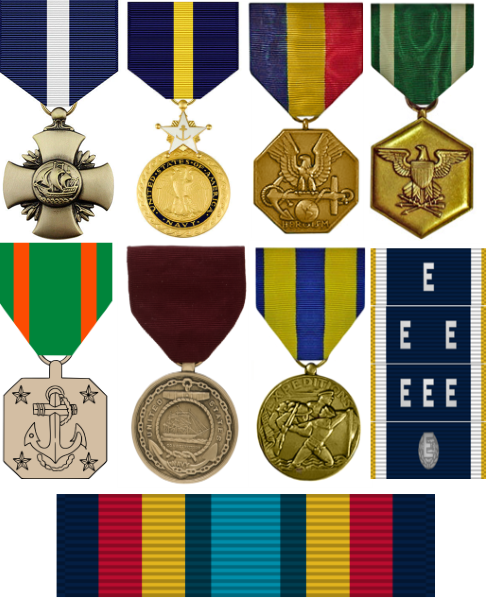U.S. Navy medals acknowledge noteworthy achievements and merit serving in the military branch.
As such, it helps to understand the various Navy medals, including their history and appearance.
Doing so allows civilians and fellow sailors to recognize the honorable achievements of the service member.
Learn more about the 10 Highest Navy Medals in terms of military rank and purpose.
Related Article – 15 US Navy Ribbons Explained
Table of Contents
10 Highest Navy Medals Explained
Navy medals serve an important purpose on the service uniform.
Often, medals are replaced by ribbons when it’s not practical to wear them with the rest of the military attire.
Nevertheless, at ceremonies and other formal events, sailors usually display Navy medals directly on the uniform.
Navy medals range in terms of purpose, history, and placement on the uniform.
Additionally, they are identifiable by knowing the appearance of the medal and adjoining ribbon.
More importantly, Navy medals are identified by their rank in terms of importance:
- Navy Cross
- Navy Distinguished Service Medal
- Navy & Marine Corps Medal
- Navy Commendation Medal
- Navy Achievement Medal
- Navy Unit Commendation Medal
- Navy “E” Ribbon
- Navy Good Conduct Medal
- Navy Reserve Meritorious Service Medal
- Navy Expeditionary Medal
Learn more about the 10 Highest Navy Medals (in regards to military rank and placement on the uniform), below:
#1. Navy Cross
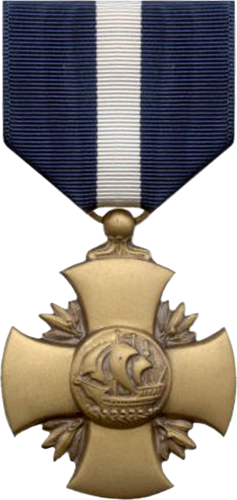
Navy medals are presented to sailors for various achievements and noteworthy honors.
As a result, the Navy Cross ranks as the second highest individual military award that a sailor can earn in the service branch. Only the Medal of Honor ranks higher.
The United States Navy awards the military decoration to select sailors (as well as Marines) who distinguish themselves by extraordinary heroism.
Generally, it occurs while engaged in combat with an armed enemy force.
For this reason, the Navy Cross is not offered to just any service member.
The military award represents the finest in military service including extraordinary courage and resilience.
The criteria for earning the Navy Cross is detailed, but generally, these heroic actions are “in the presence of great danger or at great personal risk.”
Therefore, anyone displaying this prestigious military award is saluted with incredible respect and gratitude.
The Navy Cross is the equivalent of the Air and Space Force and Coast Guard variations, as well as the Army’s Distinguished Service Cross.
It’s worth mentioning the history of the Navy Cross dates back prior to the United States getting involved in WWI.
Prior to this, the Medal of Honor was the only military decoration available to military personnel who were heroic on the battlefield.
Therefore, the Navy Cross was created in 1918 (retroactive to 1917) and remains the top military award for Navy service members.
Despite the long history, the Navy Cross is selectively awarded, and fewer than 6,500 recipients have earned it lifetime.
Nonetheless, there has been a recent increase in awards following the 9/11 attacks on the Twin Towers.
Additionally, Marines have also been recent recipients after military engagements overseas in places like Benghazi.
Since the 1940s, the Navy Cross has replaced the Distinguished Service Medal (see, below) in order of precedence on the military uniform.
Appearance of Navy Cross
The military award is represented by a medal and accompanying service ribbon.
The service medal is one of the most noteworthy in appearance featuring a modified cross-pattee design.
Additionally, the middle of the Navy medal features a sailing vessel depicted on waves with 4 laurel leaves extending from the middle.
Then, on the reverse side of the Navy Cross medal, crossed anchors guard the letters “USN.”
Finally, the Navy Cross service ribbon is a pattern of navy blue with a center white stripe identical to the suspension ribbon of the medal.
Sailors who earn multiple awards designate the achievement with gold or silver 5/16″ stars affixed to the service ribbon.
#2. Navy Distinguished Service Medal
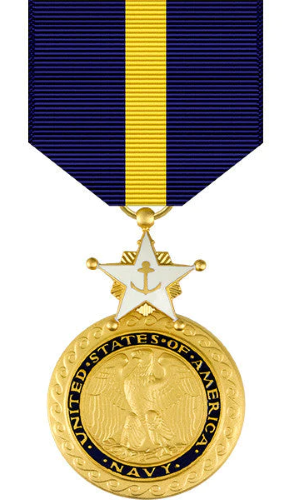
The Navy Distinguished Service Award also ranks among the top Navy medals.
Created in 1919, the Navy Distinguished Service Medal has a comparable history to the Navy Cross.
And, as previously noted, once ranked above the Navy Cross in terms of order of precedence on the military uniform.
However, since 1942, the Distinguished Service Medal has existed 3rd on the military uniform (behind the Medal of Honor and Navy Cross).
The military decoration is awarded to sailors (and U.S. Marines) who demonstrate distinguished and exceptionally meritorious service while serving in a duty or position of great responsibility.
The Navy Distinguished Service Medal rivals similar military awards under the same title presented to military personnel in the Army, Coast Guard, and Air Force.
History of Navy Distinguished Service Medal
Interestingly, the history of the Navy Distinguished Service Medal extends back to the beginning of World War I.
At the time, the Medal of Honor was the only military award that recognized acts of heroism.
Therefore, since 1919 (also retroactive to 1917), the Distinguished Service Medal has long been connected to the Navy Cross.
Both Navy medals recognize incredible accomplishments in the service branch and are equally respected.
While the criteria for receiving the Distinguished Service Medal is broad the award generally recognizes service clearly above what is normally expected.
As such, these actions or conduct contribute to the success of a major command or military operation.
Often, recipients are sailors in high-ranking Navy positions often at command in the field or at sea.
Thus, since the term “great responsibility” is usually reserved for senior Navy personnel, the decoration usually is awarded to senior Navy flag officers.
In rare instances, the Distinguished Service Medal has also been presented to Naval Captains and Marine Corps Colonels.
The bronze appearance and American bald eagle of the award also rank among the most recognizable Navy medals.
Additionally, the military ribbon is noteworthy for its navy blue and center yellow stripe design.
Like many other Navy awards on the list, additional honors are designated by 5/16″ gold or silver stars on the service ribbon.
#3. Navy and Marine Corps Medal
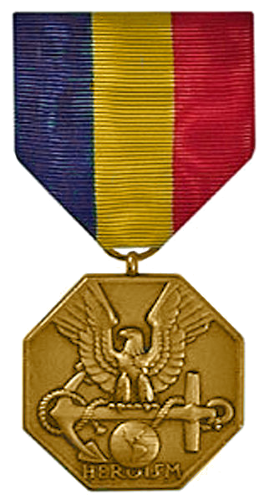
In 1942, the United States Navy established another award to share with the Marine Corps (USMC).
As such, one of the first non-conflict heroism Navy medals was created to acknowledge this type of merit.
The Navy and Marine Corps Medal has some famous recipients, including John F. Kennedy (JFK).
The former president earned the military award after rescuing members of a stranded ship during World War II.
Like many other Navy medals, the military award also has a comparable equivalent in the other service branches.
For example, the Army has the Soldier’s Medal while the Air Force and Space Force present the Airman’s Medal.
The award hinges on the actual level of personal “life-threatening” risk since the Navy and Marine Medal involves heroism in non-combat situations.
Thus, the U.S. Navy assesses each situation differently to determine the degree of “life-threatening” risk, making a sailor eligible for the award.
The military award has been around since WWII and is noteworthy based on its appearance.
The bronze medal features an octagonal shape and depicts an eagle holding a fouled anchor over a globe.
Additionally, the word “Heroism” is inscribed beneath the globe.
Lastly, the military ribbon is distinguished by a color pattern of navy blue, old gold, and apple red.
#4. Navy and Marine Corps Commendation Medal
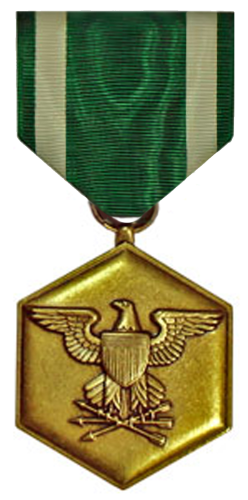
The Navy Commendation Medal ranks among the top medals in order of precedence.
It’s another military award that is shared by other service branches under the same title.
Additionally, a 5th version of the military decoration is reserved for acts of joint military service performed under the Department of Defense (DoD).
Nevertheless, each military branch has a unique history regarding when it incorporated the award.
For example, the Navy variant of the Commendation Medal has been around since 1943.
The Commendation Medal is considered a mid-level military award.
As such, it’s generally presented for sustained acts of heroism or meritorious service.
Originally, the Commendation Medal lacked an actual medal and was only designated by a service ribbon.
Thus, early recipients in the 1940s did not receive a medal, yet that was changed in the 1950s.
Navy Commendation Medal Devices
Today, the Navy Commendation Medal has many variations, including being displayed on the uniform with:
- “V” Device: It designates “valor” with an enemy.
- Combat “V” Device: Valorous actions in direct combat with an enemy.
- Combat “C” Device: Valorous actions under the most arduous combat conditions.
Recently, the Secretary of the Navy changed the name of the military award to the “Navy and Marine Corps Commendation Medal”.
However, despite the recent changes, the Navy continues to present the award more selectively compared to other military branches.
In fact, the medal is usually reserved for higher-ranking Navy officers or those nearing the “end of tour.”
Despite this, there are rare instances where more junior Navy personnel received the military decoration as an “impact award.”
Once again, additional awards are denoted by silver or gold stars attached to the service ribbon.
#5. Navy Achievement Medal
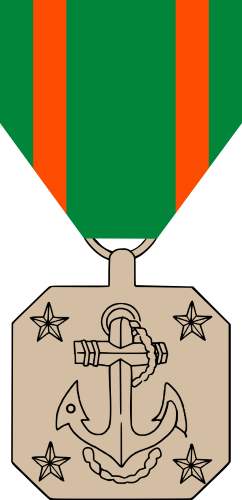
The Navy Achievement Medal is another mid-level military award in the service branch.
Nonetheless, it ranks among the more popular or commonly known Navy medals, especially regarding appearance.
The ribbon contrasts many other Navy service ribbons in a green and white design.
Meanwhile, the medal is distinguished by an anchor surrounded by 4 stars.
Furthermore, several different devices are often attached to the service ribbon, including the “C” device.
However, in 2016, the U.S. Navy changed its policy on allowing the “V” device to be displayed on the uniform.
The Navy Achievement Medal was established to recognize outstanding achievement or meritorious service.
In general, sailors who are eligible for the military decoration fall just under the requirements necessary for the Commendation Medal.
Be that as it may, the Achievement Medal still recognizes noteworthy accomplishments while serving the nation.
The Navy Achievement Medal, like the Commendation Medal, is presented in every military branch (including a 5th version for joint activity).
Nevertheless, the U.S. Navy was the first service branch to introduce the award in 1961.
Recently, the service branch adjusted the title of the award to also include the Marine Corps (USMC), like the Commendation Medal.
However, many still refer to the award as the Navy Achievement Medal, or “NAM” for short.
Typically, local commanders are delegated authority to determine who is eligible for the military award.
Thus, Navy commanders have tremendous discretion when determining who or what conduct is eligible for the award.
#6. Navy Unit Commendation Medal

The Navy Unit Commendation (NUC) Medal is another terrific accomplishment.
It’s an award reserved for military units as opposed to individual military personnel.
Accordingly, U.S. Navy and Marine Corps commands may recommend any military unit for the NUC award.
In general, Navy units distinguish themselves by outstanding heroism engaged in combat against the enemy.
Often, it serves as a substitute for those that fail to qualify for the higher-ranking, Presidential Unit Citation award.
Thus, a Navy unit must perform service of a character comparable to that which would merit the Silver Star Medal or Legion of Merit award.
These non-combat military awards acknowledge sailors who perform heroic acts outside the battlefield.
The primary stipulation is that these actions must be performed by more than one member of a unit, working together as components of a team.
It’s rare among Navy medals in that members outside the Marine Corps may also earn the award.
Generally, this occurs when an outsider member (i.e. Airman) is directly attached or assigned to a U.S. Navy component.
The Navy Unit Commendation Medal was established in 1944.
Since then, numerous Navy units have been recognized for the award and display them proudly on their service uniforms.
Those with 3/16″ bronze stars have earned multiple recognitions of the same award.
#7. Navy “E” Ribbon
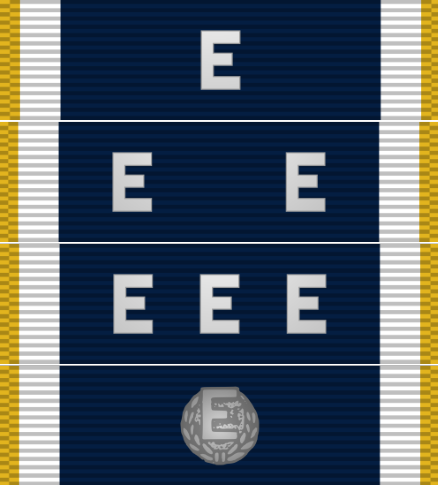
The Navy “E” Ribbon, also known as the Battle Efficiency Ribbon, was first established in 1976.
The purpose of the Navy “E” Ribbon is to recognize sailors who perform well in the battle efficiency competition.
Those who earn the Navy E-Ribbon are distinguished much differently from other Navy medals.
For starters, the Navy “E” Ribbon does not have an actual medal.
Instead, a ribbon serves as an alternative on the full dress uniform.
Thus, sailors place the ribbon above the right breast pocket of the military uniform (instead of the left side).
However, the placement of the ribbon is different when presented on a standard service uniform.
In these situations, the ribbon is placed above the left breast pocket along with the other military decorations.
The United States Coast Guard has an equivalent to the Navy “E” Ribbon, known as the “Coast Guard “E” Ribbon”.
The Navy “E” Ribbon distinguishes itself largely based on appearance, including attached devices.
Often, the Navy “E” Ribbon is supported by the silver “E” device which designates additional awards.
#8. Navy Good Conduct Medal
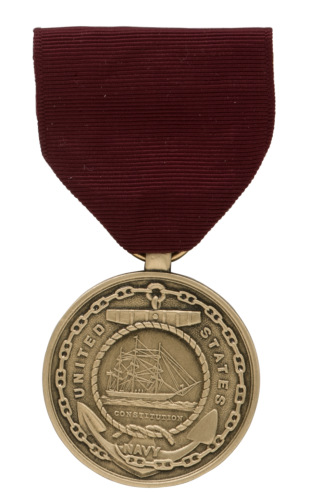
The Navy Good Conduct Medal has an incredible history and remains as one of the oldest military awards in the U.S. Armed Forces.
The Navy’s version of the Good Conduct Medal was first established in 1869.
Eventually, the United States Marine Corps would follow in 1896, along with the Coast Guard (1923), Army (1941), and Air Force (1963).
Be that as it may, the Navy Good Conduct Medal easily remains the longest-lasting, with origins that began in the 19th century.
For this reason, many recipients consider it a tremendous honor and are grateful for the award.
It’s among the most valued Navy medals, especially when you consider the long history that spans 150 years.
The criteria for receiving the Good Conduct Medal is 3 consecutive years of “honorable and faithful service.”
In general, the term “honorable and faithful service” refers to a standard that falls above and beyond the minimum requirements of military duty.
Nonetheless, those who fail to complete 3 consecutive years of “good conduct” service are eligible for reinstatement.
Thus, for example, a sailor who is disciplined may eventually earn the military award by changing his or her habits and completing 3 years of good service.
Consequently, those with disciplinary infractions or court martial offenses may still be eligible in the future.
Moreover, it’s important to note that the length requirement (3 years) is reduced to 1 year during times of war.
Furthermore, the Navy Good Conduct Medal is awarded posthumously to qualifying enlisted personnel.
Navy Good Conduct Variants
The Navy Good Conduct Medal has witnessed several variations in appearance, including the most current variant.
Initially, the first design lasted until 1884 before it was gradually replaced by the current version in 1961.
Today, the current version of the medal is known for the words “Fidelity, Zeal, and Obedience” on the reverse side.
Additional awards are designated by 3/16″ stars with the silver version the equivalent of 5 bronze stars.
#9. Navy Expeditionary Medal
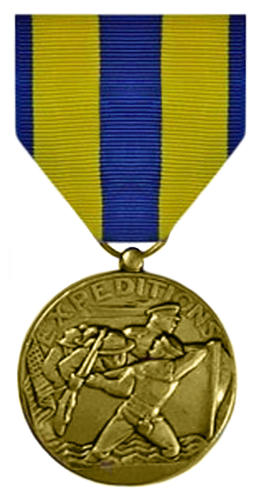
The Navy Expeditionary Medal is another significant military award in the service branch.
It ranks among the top Navy medals in order of importance and has an outstanding tradition.
The Navy military award was first presented in 1936 to both officers and enlisted personnel.
In general, qualifying sailors must have:
- Landed on foreign territory and engaged in operations against armed opposition; or
- Operated under circumstances which, after full consideration, shall be deemed to merit special recognition for which service no campaign medal has been awarded.
In other words, the military award recognizes noteworthy achievements or merit while serving the country.
Interestingly enough, the Expeditionary Medal is one of the few awards that are also not presented to members of the Marine Corps.
However, the United States Marine Corps (USMC) does feature its own version of the military decoration.
The medal features a unique design depicting a sailor breaching a craft full of Marines.
Then, an officer with a U.S. flag waves it underneath the word “Expeditions”.
Meanwhile, the reverse side of the Navy Expeditionary Medal is identical to the Marine Corps variant.
There is a civilian equivalent to the award presented to select personnel who were deployed to Iraq or Afghanistan during the Global War on Terror (GWOT).
Additionally, service members who were involved in the Wake Island defense are also eligible for the military award.
#10. Navy Sea Service Ribbons

Finally, Navy Sea Service Ribbons and medals are offered to qualifying personnel aboard ships and other vessels.
The military branch offers various sea service ribbons, including:
- Navy & Marine Corps Sea Service Ribbon
- Navy Reserve Sea Service Deployment Ribbon
- Navy Arctic Sea Service Medal
Furthermore, the U.S. Coast Guard and Army also feature their own versions of the military decoration.
Then, there is the Sea Service Ribbon offered by the NOAA Commissioned Officer Corps.
Often, the primary stipulation is that the sailor performed service while forward-deployed and away from their home unit.
The Navy and Marine Corps Sea Service Deployment Ribbon has been around since 1980 and is retroactive to the 70s.
Generally, sailors are eligible once they complete:
- 90 consecutive days of sea service; or
- Two separate periods of at least 80 days (within a 12-month period); or
- 6 months stationed overseas in a forward deployed location.
Moreover, staffs of Amphibious Readiness Groups (ARG), Expeditionary Strike Groups (ESGs), and other special squadrons are eligible.
It’s unique among Navy medals in that crews are also allowed to display the award on ships and hangars.
Lastly, additional awards are denoted by 3/16″ bronze and silver stars.
Conclusion
Navy medals exist in all shapes and sizes.
The appearance of the medal (and accompanying service ribbon) distinguishes each award from other military decorations.
Therefore, learning about the history, purpose, and appearance of the military award goes a long way.
These Navy medals are ranked in order of precedence on a full-dress military uniform.
- Ikon Pass Military Discount: Learn How To Save Big - January 31, 2025
- RTIC Military Discount: Find Out How To Save Big on Gear - January 30, 2025
- Traeger Military Discount: Learn How To Save Big on Smokers - January 28, 2025

